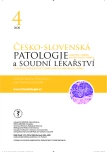Případ úpalu pod vlivem psychotropních látek
Authors:
Kinoshita Hiroshi 1; Tanaka Naoko 1; Kumihashi Mitsuru 2; Jamal Mostofa 1; Ito Asuka 1; Nagata Ken 1; Tsutsui Kunihiko 3; Kimura Shoji 1
Authors‘ workplace:
Department of Forensic Medicine, Faculty of Medicine, Kagawa University, Kagawa, Japan
1; Forensic Science Laboratory, Kagawa Prefectural Police Headquarters, Kagawa, Japan
2; Health Sciences, Faculty of Medicine, Kagawa University, Kagawa, Japan
3
Published in:
Soud Lék., 65, 2020, No. 4, p. 76-78
Category:
Overview
V článku prezentujeme fatální případ úpalu po požití olanzapinu a levomepromazinu. V polovině srpna byl ve své skladištní místnosti v Japonsku nalezen muž bez známek života. V době ohledání, přibližně sedm hodin po jeho smrti, měl rektální teplotu 40,1°C. Teplota okolního prostředí byla 30,2°C, nejvyšší teplota v místnosti v průběhu dne dosahovala 36°C. Histopatologické nálezy prokázaly hyperkontrahovaná vlákna v kosterních svalech. Kvantitativní toxikologická analýza pomocí tandemové hmotnostní spektrometrie s kapalinovou chromatografií (LC-MS/MS) odhalila koncentrace olanzapinu, levomepromazinu, 7-aminonitrazepamu (metabolit nitrazepamu) a 7-aminoflunitrazepamu (metabolit flunitrazepamu) ve vzorku femorální krve 0,433 µg/ml, 0,177 ug/ml, 0,604 ug/ml, respektive 0,041 ug / ml. Ze vzorku post mortem odebrané krve nebyly detekovány žádné další léky ani ethanol. Koncentrace myoglobinu v moči byla 3000 ng/ml. Koncentrace olanzapinu překročila toxické hladiny; hladina levomepromazinu však byla v terapeutickém rozmezí. Protože jak olanzapin, tak levomepromazin působí blokováním muskarinových receptorů, mohou potlačit pocení a narušit odvod tepla. Na základě makroskopických pitevních nálezů, histologických nálezů svědčících o rozpadu svalů, výsledcích toxikologických vyšetření a vyšetřování úřadů jsme dospěli k závěru, že příčinou úmrtí byl úpal způsobený olanzapinem a levomepromazinem.
Klíčová slova:
olanzapine – levomepromazine – úpal
Sources
Baselt RC. Olanzapine. In: Disposition of toxicdrugs and chemicals in man (8th ed). Foster City: Biomedical Publications; 2008: 1140-1143.
Richelson ER. Receptor pharmacology of neuroleptics: relation to clinical effects. J Clin Psychiatry 1999; 60 (supple 10): 5-14.
Baldessarini RJ, Tarazi FI. Pharmacotherapy of psychosis and mania. In: Brunton LL, Lazo JS, Parker KL, eds. Goodman & Gilman’s The pharmacological basis of therapeutics (11th ed). New York, Chicago: McGraw-Hill; 2006: 461-500.
Baselt RC. Methotrimeprazine. In: Disposition of toxic drugs and chemicals in man (8th ed). Foster City: Biomedical Publications; 2008: 971-973.
Muench J, Hamer AM. Adverse effects of antipsychotic medications. Am Fam Physician 2010; 81: 617-622.
Brown JH, Taylor P. Muscarinic receptor agonist and antagonist. In: Brunton LL, Lazo JS, Parker KL, eds. Goodman & Gilman’s The pharmacological basis of therapeutics (11th ed). New York, Chicago: McGraw-Hill; 2006: 183-200.
Obara K, Horiguchi S, Shimada T, et al. Characterization of binding of antipsychotics to muscarinic receptors using mouse cerebral cortex. J Pharmacol Sci 2019; 140: 197-200.
Zhu BL, Ishida K, Quan L, et al. Post-mortem urinary myoglobin levels with reference to the causes of death. Forensic Sci Int 2001; 115: 183-188.
Kinoshita H, Tanaka N, Takakura A, et al. Flunitrazepam in stomach contents may be a good indicator of its massive ingestion. Rom J Legal Med 2017; 25: 193-195.
Madea B. Injuries due to heat. In: Handbook of forensic medicine. Madea B, ed. West Sussex: Wiley Blackwell; 2014: 451-467.
Kinoshita H, Kubota A, Nishiguchi M, et al. Three autopsy cases of heat illness. Res Pract Forens Med 2005; 48: 173-177.
Schulz M, Iwersen-Bergmann S, Andresen H, Schmoldt A. Therapeutic and toxic blood concentrations of nearly 1000 drugs and other xenobiotics. Crit Care 2012; 16: R136.
Kinoshita H, Tanaka N, Takakura A, et al. Medicologal implications of an autopsy case of hypothermia under the influence of flunitrazepam and quetiapine. Rom J Legal Med 2018; 26: 67-69.
Moriya F, Hashimoto Y. Tissue distribution of nitrazepam and 7-aminonitrazepam in a case of nitrazepam intoxication. Forensic Sci Int 2003; 28: 108-112.
Drummer OH, Odell M. Monographs of selected drugs. Benzodiazepine. In: The forensic pharmacology of drugs of abuse. London: Arnold; 2001: 382-405.
Grogan H, Hopkins PM. Heat stroke: implications for critical care and anesthesia. Br J Anesth 2002; 88: 700-707.
- Bark N. Deaths of psychiatric patients during heat waves. Psychiatr Serv 1998; 49: 1088-1090.
- Lee C-P, Chen P-J, Chang C-M. Heat stroke during treatment with olanzapine, trihexyphenidyl and trazodone in a patient with schizophrenia. Acta Neuropsychiatr 2015; 27: 380-385.
- Yang C-H, Chen Y-Y. A case of olanzapine-induced fever. Psychopharmacol Bull 2017; 47: 45-47.
- Bhanushali M, Tuite P. The evaluation and management of patients with neuroleptic malignant syndrome. Neurol Clin 2004; 22: 389-411.
Labels
Anatomical pathology Forensic medical examiner ToxicologyArticle was published in
Forensic Medicine

2020 Issue 4
Most read in this issue
- Autoerotic deaths: report of two unusual cases
- An autopsy case of heatstroke under the influence of psychotropic drugs
- The reasons for reoperations after surgery for acute subdural hematoma and the implications of suspected injury mechanisms
- MUDr. Jaromír Hrubecký osmdesátiletý
